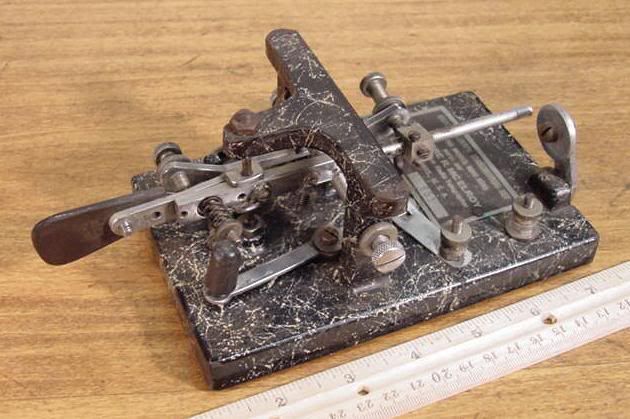In addition to Sunday being Christmas Eve, there'll be another observance taking place among those of us who have RF running in our veins.
Dec. 24th will be the 100th anniversary of the transmission of the human voice by Canadian Reginald Fessenden. Of course, this anniversary actually is for the first “broadcast” of human voice, as Fessenden's transmissions 100 years ago were entertainment aimed at shipboard operators. It was also the first instance of mike fright — Bible readings by Fessenden's wife and secretary had to be covered by Fessenden after they froze up in (presumably) terror before a radio audience.
Kudos to ARRL PR guru Allen Pitts for his work on the League's PR campaign built around the Centennial. I don't know if there's a campaign to follow this, but it will be a tough act to follow.
FCC R&O ON MORSE TESTING. The FCC's Report & Order on ending the Morse code requirement was published a couple of days ago. It won't be published until after year's end, so the changes won't go into effect until February.
I've not heard nearly as much whining and complaining as I expected about all of this. I think most hams — particularly those who themselves don't use CW much — recognize that knowing the code doesn't improve the quality of amateurs who enter our ranks, nor is it the lifesaving emergency communications mode it once may have been.
It's interesting to look at the pages of QST over the years. Ones I have go back to the early 1920s, and a common thread in ham radio the past 85 years has been “change.”
Actually, “upheaval” might be more correct at various times in history. For example, imagine being an amateur in December 1928.
In 1927 a gathering called “the Washington (D.C.) conference” led to some major changes for amateur operators and their stations. Amateurs had until Jan. 1, 1929 to rebuild their stations to meet new regulations crafted by the Federal Radio Commission that required hams to stay within certain frequency bands — a concept that had been in place but not enforced. The new rules required hams to improve the purity of their transmitted signals — which meant you could no longer run straight AC power to the plates of your output tubes.
The new rules were announced in 1927 in order to give amateurs plenty of time to rebuild — and to figure out how they might afford to have a transmitter that met the regs, an issue that QST spent many pages on helping hams solve.
Of course, during this period, amateurs were under increasing pressure to “fix” their BCL (Broadcast listener) interference problems. The new regs were a big help, but not enough.
There are plenty of other instances of upheaval in amateur radio, be it focused on hardware, rules or just changes in social interaction. Much like a large family, there's always on faction that's angry at another for whatever reason. The League and QST have served as both news service and arbiter of these disputes.

SANTA DO YOU HEAR ME? “All I want for Christmas is a brand new bug …” OK, not a brand new bug, but I'm still on the hunt for a 1930s Mac Key, designed and sold by world champion telegrapher Ted McElroy.
The one pictured here sold recently on eBay,and had I had the funds I would have snapped it up. This is a 1938 Mac Key De Luxe. Unlike Vibroplex, whose “deluxe” keys had nickel or chrome-plated bases, ol' Mac believed a telegrapher's key should not have a chrome base … called it a “distraction.” His “deluxe” keys had a “Marbleite” finish which gave it a distinctive look. The deluxe Mac Keys are quite collectible, and I'm at a loss to understand why this key sold so cheaply ($142.50 on eBay). It's in good shape, but it is not complete, so that's probably why it did not bring top dollar — which these days has been $200-300.
For starters, the key is missing the weights — and finding original weights to replace them correctly is unlikely unless you unearth someone's private cache of Mac Key spares.
The key is missing the dash contact slide (the part on the key lever that phyisically holds the dash contact); the dot contact on the pendulum is missing too. The key is missing the finger piece (the round knob) from the keying lever. But overall, it's not a bad piece. I could live with replacement parts just fine, me thinks.
These keys, by the way, are made of cast iron, so they're quite heavy. The 1936 Mac Key I own is a brute. The main spring on the keying lever is stiff, and operating the key takes a rather firm hand. I got my Mac Key out of its box recently, I didn't put it in action much because it lacks rubber feet. If I have the correct thread machine screws I believe Vibroplex feet will work fine.
And speaking of bugs, I've a self-imposed moratorium on eBay purchases. Well, no more ham stuff of consequence until after Christmas, anyway! Of course there's exceptions to that rule — if a nice Mac Key or other Morse key or other gizmo I can't live without is listed, then it's fair game. I've had computer problems lately, so I've not been able to peruse eBay much anyway.
73 es Merry Christmas …. de KY4Z SK dit dit ….
